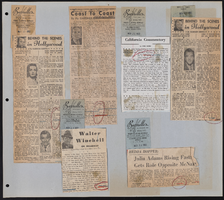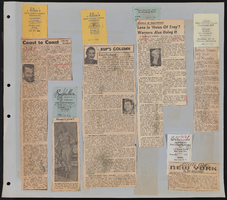Search the Special Collections and Archives Portal
Search Results
Blanche Zucker-Bozarth Photograph Collection
Identifier
Abstract
The Blanche Zucker-Bozarth Photograph Collection contains black-and-white and color photographic prints, negatives, and slides of Blanche Zucker-Bozarth between approximately 1980 and 2000. These images depict Zucker-Bozarth attending University Library Society gatherings at the University of Nevada, Las Vegas (UNLV), community fundraisers and events, and award ceremonies. During University Library Society gatherings, Zucker-Bozarth is seen with UNLV Libraries and campus-level administrative faculty and associates. The collection also contains Zucker-Bozarth attending events for the WE CAN (Working to Eliminate Child Abuse and Neglect) Fundraiser and the President’s Child Safety Partnership. Other photographs include Zucker-Bozarth holding the Chicago Award, Zucker-Bozarth posed with Mesquite Club members, and various individuals in Las Vegas and Carson City, Nevada.
Archival Collection
Charles Vanda Photograph Collection
Identifier
Abstract
The Charles Vanda Photograph Collection, approximately 1960 to 1988, contains black-and-white and color photographic prints with some corresponding negatives of Charles Vanda with colleagues and friends from the University of Nevada, Las Vegas (UNLV). The images depict Vanda at UNLV sporting events, graduation ceremonies, and other campus events. Also included are some images from fellow musicians, entertainers, and producers associated with Vanda.
Archival Collection
Rena Nora Papers on Gambling Addiction
Identifier
Abstract
The Rena Nora Papers on Gambling Addiction (1978-2009) consist of the personal correspondence, research notes, and publications of psychiatrist Rena Nora. In addition to positions in New Jersey and New York, Dr. Nora was the Chief of Psychiatric Services at Nellis Air Force Base in Las Vegas, Nevada, where she focused on issues of compulsive gambling. The papers also house several compact disks which contain presentations that Dr. Nora gave at various conferences on problem gambling in the United States.
Archival Collection
Charles Vanda Collection
Identifier
Abstract
The Charles Vanda Collection (1955-1987) is comprised of achievement awards, plaques, and certificates that were presented to Charles Vanda throughout his career as a television and radio writer, director, and producer. Also included are newspaper clippings and articles about Charles Vanda, the performing arts, and the University of Nevada, Las Vegas (UNLV), a doctoral hood and a UNLV Runnin' Rebels jacket.
Archival Collection

Transcript of interview with Byron Underhill by Joyce Moore, March 20, 2002
Date
Archival Collection
Description
Byron Underhill's father owned the first Coca-Cola bottling plant, the first beer distributorship, and the first bowling alley in Las Vegas. Byron moved here from Needles, Calif., with his family in 1927. Byron later took over the bottling plant, served in the Army as an aircraft mechanic and a glider pilot during World War II, was a private pilot who worked with Search and Rescue, played in various bands, and suggested to the Lions club that they found a burn unit at University Medical Center that is still the only one in the state
Text

Transcript of interview with Adelaide Robbins by Lisa Gioia-Acres, April 18, 2008
Date
Archival Collection
Description
Adelaide was born in Manhattan, New York to a father who was a pianist and arranger and a mother who was a dancer on Broadway. She grew up as an only child in the theater district where she was exposed to the arts from a young age. Her parents insisted she be well rounded. To that end, she began piano lessons at age six and was frequently taken to museums. Adelaide was always drawn to music and began working professionally by the age of 12. She attended the High School of Music and Art for four years along with others who went on to great fame. While in high school, she earned awards for composition. Her knowledge and abilities of the bass earned her a full scholarship to the Eastman School of Music. All of the jobs she had during high school and college were music related; playing gigs or teaching. While working towards a triple major at Eastman, she felt over-extended and eventually transferred to the Manhattan School of Music who was honored to have a transfer from Eastman. Also because of the extra credits from Eastman, she was able to obtain a master’s degree inside of a year. Adelaide went on the road with Buddy Rich’s band where they played in Chicago and Los Angeles before finding their way to Las Vegas. Adelaide was always the only woman in the band, and there were difficulties of being a woman in the field of mostly male musicians. The band found their way to Las Vegas in 1967. She never realized how well known she was until she arrived in Las Vegas. Adelaide came to Las Vegas on a trial run and ended up staying. The first job she had in Las Vegas was playing solo piano at Guys and Dolls before moving on to playing as a rehearsal pianist for a Broadway show. Over the years, Adelaide played many venues with many famous musicians. She is not hopeful for the future of musicians in Las Vegas, feeling the casino owners would rather replace live musicians with canned music. However, Adelaide’s career is not over as she is still performing for a variety of events. With her two degrees from very prominent music schools, Adelaide feels she may have gone further in career if she had stayed in New York, but she has no regrets about coming to Las Vegas.
Text




